Step by Step on The Way of Saint James
From Olveiroa to Finisterre
14 June 2018
Stage 35 – Km. 32

– Last day on The Way! –
Today marks the end of my pilgrimage through the lands of northern Spain.
We leave the hostel at 06:00. Once again, we set off early given the thirty-two kilometres that await us.
The weather today is perfect: a beautiful blue sky, the sun shining brightly, and temperatures that feel more like spring.
Looking back at the first stage in the Pyrenees, I can say that this journey ends with the same fine weather it started with.
I set off with Rocco and Giovanna, forming a steady trio until the very last day. Today, we are also joined by Karen, our new friend from Taiwan.
We have already been walking for nearly an hour when we arrive at O Logoso, the first village along this route.
Since we left the hostel on an empty stomach, we stop at the bar of Pensión A Pedra for breakfast.
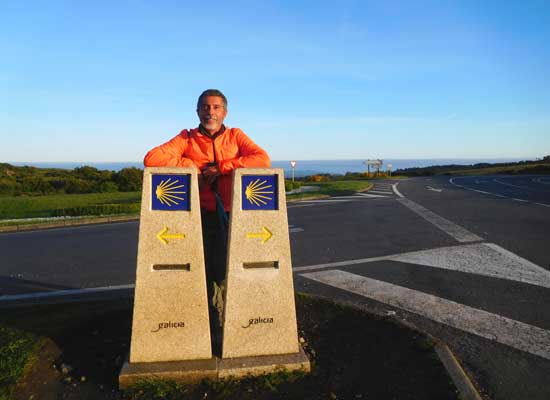
Shortly after passing the village of Hospital, The Way presents us with a fork.
Two milestones, placed side by side, indicate the possible directions: to the left lies Finisterre, while to the right, the path leads to Muxía.
Without hesitation, we decide on Finisterre.
From here, there are 29.693 kilometres left to our destination.
The landscape begins to change, and with the sea not far away, the air already carries the scent of salt.
The scenery is marked by woods, no longer dense, and wide green meadows. These gentle hills gradually lead us to lower altitudes.
It is said that every road or path in Galicia leads to the sea, and this saying is quickly explained by the fact that roughly half the region’s perimeter—about 1,500 kilometres—is bathed by the Atlantic Ocean to the west and the Cantabrian Sea to the north.
The Galician coastline boasts a great variety of landscapes: long beaches, rugged cliffs, and narrow fjords called “rías,” where the sea penetrates inland.
About four kilometres after the fork towards Finisterre, we encounter another Roman-era religious building: the chapel of Nosa Señora das Neves.
Its peculiarity lies in an outdoor chapel with a stone altar where religious ceremonies are held under the open sky during major gatherings and pilgrimages.
While pausing to admire this distinctive church, I meet a group of Portuguese women.
I continue walking with them, and since they are all from Porto—the city where I will spend my last night before flying back to Italy—I take the opportunity to ask for some practical tips about their city.
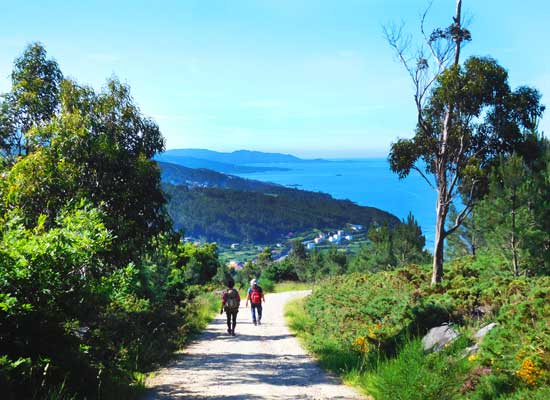
After another five kilometres, it is just past 10:00 when we reach Alto de Armada.
Unlike Christopher Columbus’s lookout, who cried out – Land! Land!!! – we can joyfully exclaim – Sea! Sea!!! –
Finally, we catch a glimpse of the Atlantic Ocean and the cape of Finisterre in the distance.
After more than a month of landscapes featuring mountains, hills, and plains, seeing the sea is an overwhelming emotion—further amplified by the fact that we are nearing the conclusion of our long journey.
Alto de Armada stands at 247 metres and marks the beginning of a steep descent. In no time, we reach the village of Cee, just a few metres above sea level.
Past Cee, and shortly after Corcubion, we feel almost there. Yet, there are still about ten kilometres to Finisterre and another three to the cape.
However, the increasingly vast and beautiful views of the sea give us the energy to quicken our pace. The destination is now within reach and looks very inviting.
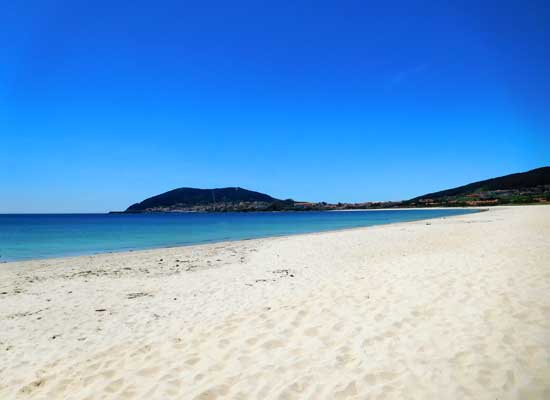
At about 13:45, we reach the beginning of the praya de Langosteira: a crescent-shaped stretch of pale sand, about two kilometres long and a hundred metres wide.
The sea laps gently against it, displaying colours that fade from green to blue.
At its far end, the village of Finisterre is already visible, and beyond it, the imposing headland of the cape.
With a cloudless blue sky and brilliant sunshine, every colour appears more vivid, creating a picture-perfect view.
Before setting off along the beach, we pause for a moment to fully take in the beauty of this scene.
We take the chance to chat with the owner of “La Capannina,” a small beach bar strategically located at the end of The Way of Saint James.
Francesca, her name, is Italian. She and her partner have run this tiny place for several years—a dream come true for those who long to leave everything behind and open a beach bar on some exotic shore far from Italy.
We only linger for a few minutes, as we are eager to reach the sea.
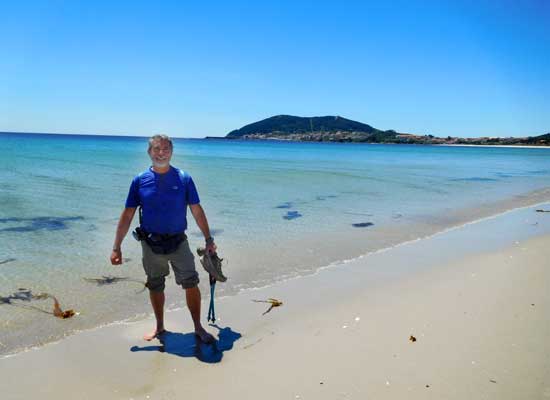
We quickly cross the beach, drop our backpacks, and shed our boots and thick socks.
– At last, we can dip our feet in the waters of the Atlantic Ocean! –
We feel like kids seeing the sea for the first time, and this moment definitely ranks among the most joyous and memorable of the entire Way.
As always, we capture the moment with countless photos.
At the same time, like the ancient pilgrims, we collect a few shells scattered across the sand.
We continue walking along the two kilometres of the beach, barefoot in the water.
The sensation is wonderful, and the temptation to strip off and dive in is strong; however, for now, the goal is to reach the final destination, and so we postpone the swim until later.
At the end of the beach, we arrive in the village of Finisterre.
Before covering the last three kilometres that lead to “Km Zero,” we need to find a hostel.
To our great disappointment, the municipal one informs us that there are no more available beds.
While we are there, we get the final stamp on our Pilgrim’s Credential. At the same time, we request the “Finisterrana,” a certificate confirming the journey from Santiago de Compostela to Finisterre.
Finding a hostel proves to be no easy task and takes some time. After a few attempts, we finally secure beds at Albergue Cabo da Vila, not far from the centre.
After grabbing a quick snack at a local spot near the harbour, it is 16:30 when we set off to complete the short stretch that will bring The Way of Saint James to its conclusion.
In one sense, the path is not particularly thrilling since we walk alongside the road with cars passing close by. On the other hand, it is quite scenic, offering panoramic views of the sea.
Whether this part of the route is beautiful or not depends entirely on how we choose to look at it: turning our heads to the right, we see the unpleasantness of traffic; turning to the left, we admire nature’s splendour.
This duality of perspectives seems to offer one final lesson from The Way.
– The reality of any situation depends on the viewpoint and can take on entirely different meanings. –
It is up to us to change position and look at the same scene from another angle, whether to understand someone else’s perspective or to find a positive outlook in a particular situation.
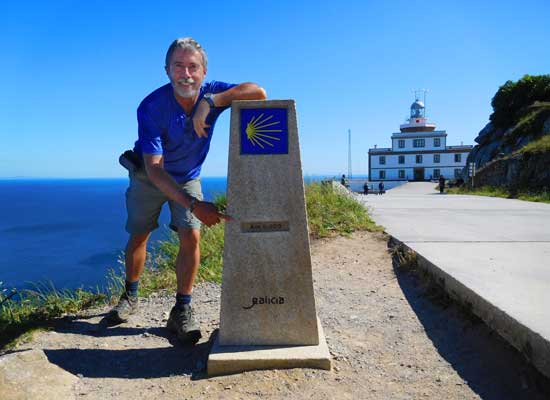
It is 17:30 when we finally stand before the last milestone, marking “Km Zero.”
Together with Rocco and Giovanna, we pause just before it; we synchronise our steps and cross the long-awaited finish line at the same moment.
A symbolic gesture to celebrate, once again, the friendship born along The Way.
Reaching this ultimate goal brings us another moment of uncontainable joy.
– The Way of Saint James is complete! –
By the time I arrive here, the total distance I have walked adds up to 854 kilometres—practically the same as the distance between Piazza del Plebiscito in Naples and Piazza del Duomo in Milan, passing through Rome, Siena, Florence, Bologna, and Piacenza.
The Way of Saint James has been a journey rich in emotions, but also marked by effort and physical pain. More than my legs, it was my “mind” that kept me going.
I walked for many days in the rain, cold, and wind—unusual weather for this time of year, yet it often proved to be a blessing, especially during the feared “mesetas,” sparing me from suffering in excessive heat.
The few sunny days I encountered coincided with the most significant stages of the journey, including crossing the Pyrenees and today’s arrival at the sea.
One of the greatest aspects of my journey on The Way has certainly been meeting so many wonderful people from every corner of the world, sharing joys and struggles over many days and kilometres.
Among those I met, I cannot fail to mention Franco and Peppe from Naples, Rosario and Nicola from Palermo, Juanì and Salvador from Spain, Dante from Civitavecchia, Giulia from Brescia, and Amandine from Belgium.
Among all, however, a special mention goes to Giovanna, the determined young woman from Sassari with whom I walked from Burgos onwards, and Rocco from Turin, whom I met on the first day in Saint-Jean-Pied-de-Port and with whom I shared every stage from Pamplona onwards.
The list of names could go on. Many have been featured in this account, while others remain firmly in my memories.
Reaching “Km Zero” after such a long journey is an event that will surely remain engraved in our memories. To make it even more permanent, we capture it in the digital memory of our cameras.
Just as we did in front of the cathedral in Santiago, we commemorate the moment with countless photos, also including other pilgrim friends we met along the way and reunite with here at the end—like Valentina from Parma and Uwe from Denmark.
Once the celebrations are over, we still have a few more steps to take.
A little beyond “Km Zero,” we first see the evocative lighthouse of Cabo de Finisterre, and then the cliff plunges into the Atlantic Ocean with a drop of about six hundred metres.
– Before our eyes, and all around us, there is only water—nothing but water! –
Today, we know very well that beyond this seemingly infinite sea lies the American continent. But in the past, reaching this point meant arriving at the “end of the earth,” where people believed nothing existed beyond.
In reality, Spain’s westernmost point is Cabo da Nave, a few kilometres further west and north of Finisterre.
However, the westernmost point of mainland Europe is Cabo da Roca in Portugal, on the same latitude as Lisbon.
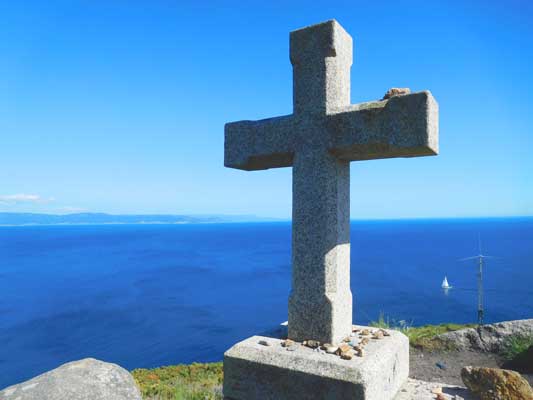
A stone cross is the only symbolic marker at Cabo de Finisterre.
There are many visitors here—both pilgrims and tourists.
Most are silent, absorbed in their thoughts, just as we are.
Tradition holds that, upon reaching the end of The Way, one should rid themselves of all unnecessary burdens by burning them here, symbolically returning lighter and free of excess.
Personally, I don’t feel I have anything to discard. Everything I packed in my backpack has proven useful and essential.
I also believe it is unwise to abandon anything, as it risks turning this beautiful cliff into a rubbish dump.
I’m pleased to see that others seem to share my view and simply enjoy the scenery, taking a few photos.
It is 18:30, and we have been here for an hour already.
We consider waiting for sunset, but since it’s expected around 21:30, it feels too long to stay—especially since there’s nothing else to do here but admire the view.
Moreover, a strong wind is blowing, and the weather suggests that haze will likely set in before the sun disappears.
We decide to head back, also because we still have three kilometres to walk to return to the village.
Once back in Finisterre, after “wandering” on foot for thirty-five days, I consider my journey on The Way of Saint James officially complete. From this moment on, everything that follows will be purely tourism.
| © Aldo Lardizzone 2020 |  |
CREATIVE COMMONS |
Muxía and Santiago de Compostela



